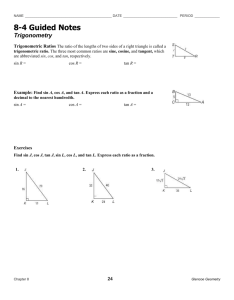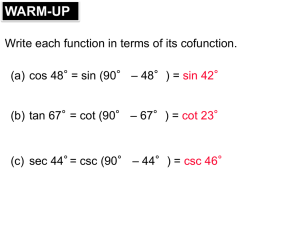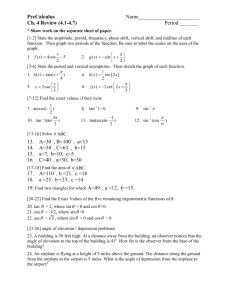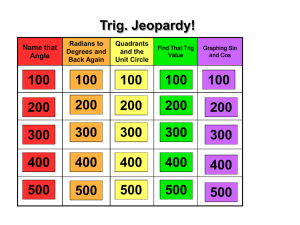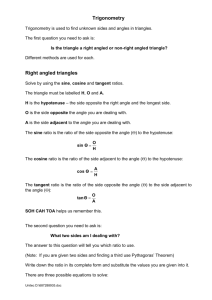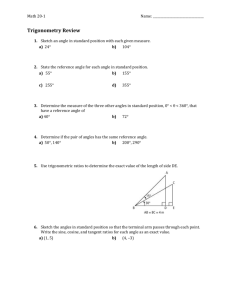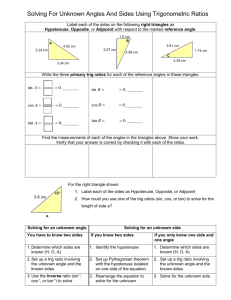Microsoft Word 97 - 2003 Document
advertisement
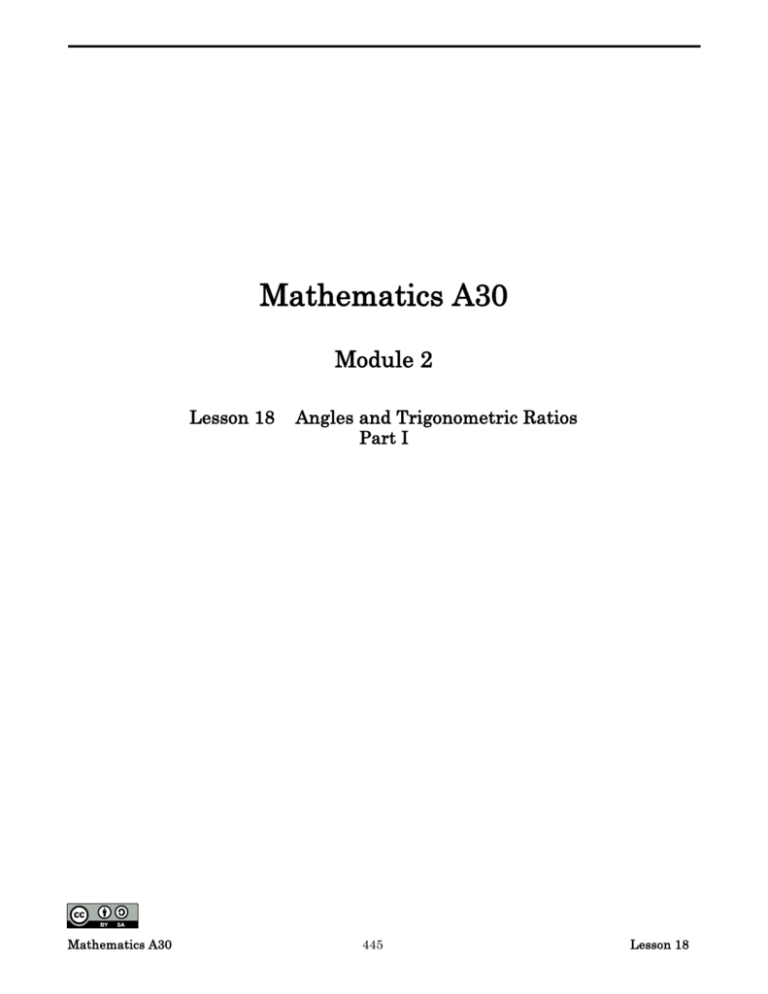
Mathematics A30 Module 2 Lesson 18 Mathematics A30 Angles and Trigonometric Ratios Part I 445 Lesson 18 Mathematics A30 446 Lesson 18 Angles and Trigonometric Ratios Introduction Lesson 18 will expand your knowledge of the six trigonometric ratios for all possible angles. You will examine what occurs to the ratios as the terminal arm, of an angle in standard position, revolves through the coordinate system. Reference angles are also introduced for a quicker method of solving larger angles. The Primary Ratios are sine, cosine, and tangent. Mathematics A30 447 Lesson 18 Mathematics A30 448 Lesson 18 Objectives After completing this lesson, you will be able to • determine coterminal angles for a given angle. • determine the value of the six trigonometric ratios when given a point on the terminal arm of an angle in standard position. • determine the reference angle for positive or negative angles. • determine the signs of the trigonometric ratios for any quadrant. • determine the values for the six trigonometric ratios, when given one trigonometric ratio and the quadrant in which the angle terminates. Mathematics A30 449 Lesson 18 Mathematics A30 450 Lesson 18 18.1 Coterminal Angles Three Diagrams showing positive angles in standard position. In lesson 17, standard position was defined and it was noted that the terminal arm of an angle could fall anywhere in the coordinate system. When the terminal arm is rotated counterclockwise, as in the above three angles, a positive angle results. An angle is in standard position when the initial arm lies on the positive x-axis with its vertex at the origin (0,0). In lesson 18, we will start by looking at negative angles in standard position. Diagram of three negative angles in standard position. Mathematics A30 451 Lesson 18 • Notice the direction of rotation for negative angles is clockwise. • A positive or negative angle is determined by the direction of rotation. Counterclockwise Rotation = Positive Angle Clockwise Rotation = Negative Angle Example 1 Draw an angle whose measure is: i) ii) iii) 35 35 125 Solution: Use your protractor to measure the angles. i) ii) iii) Example 2 In what quadrant does an angle, in standard position lie, if its measure is: i) ii) iii) Mathematics A30 190 295 160 452 Lesson 18 Solution: i) ii) Quadrant Two iii) Quadrant One Quadrant Three Different angles, placed in standard position, may have the same terminal arm. Example: Angles in standard position whose terminal arms coincide are called coterminal angles. Mathematics A30 453 Lesson 18 Example 1 Determine three positive and three negative coterminal angles for 50 . Solution: Positive Angles – Counter clockwise Rotation y y 410° 50 360 410 Mathematics A30 y 770° x 50 360 360 770 454 1130° x x 50 360 360 360 1130 Lesson 18 Negative Angles - Clockwise Rotation y y x – 310° x x – 670° 50 360 310 • y – 1030° 50 360 360 670 50 360 360 360 1030 There are infinitely many angles coterminal with a given angle. The principle angle of any given angle in standard position is the smallest positive angle in standard position which is coterminal with the given angle. Example 2 A) B) What is the principal angle whose measure is 240 ? What is the principal angle whose measure is 840 ? Solution: A) B) y 120° x 840° Principal angle Mathematics A30 120 Principal angle 455 120 Lesson 18 • If the principal angle has a measure of 50 then all other angles coterminal (as seen in Example 1) with it can be written 50 + n 360 , n I , where n is any integer. I = ... 3 , 2 , 1, 0 , 1, 2 , 3... Check If n = 0, the measure is 50 . If n = 1, If n = 2, If n = 3, the measure is 410 . the measure is 770 . the measure is 1130 . If n = 1 , If n = 2 , If n = 3 , the measure is 310 . the measure is 670 . the measure is 1030 . } } Principal Angle Positive Angles Negative Angles General Form - For writing coterminal angles If A represents any angle, then all angles coterminal with A are represented by + n 360 , n I , where is the principal angle. Example 3 Determine the general form of the coterminal angles for an angle whose measure is 215 . Solution: Find the principal angle. • Sketch given angle. 215° = 180° + 35° • Locate smallest, positive angle 180 35 145 The principal angle measures 145°. Substitute principal angle into general form equation. 145 n 360 , n I Mathematics A30 456 Lesson 18 Exercise 18.1 1. Determine three positive and three negative coterminal angles for each of the following. a. b. c. d. e. f. 2. Find the principal angle for each of the following angles. a. b. c. d. e. f. 3. 60° 125° 305° 180° 75 105 30 690° 330 315 780° 1065° Write the general form of the coterminal angles for each of the following. a. b. c. d. 45° 173° 50 243 18.2 Trigonometric Ratios and Trigonometric Functions The relationships between the angles and the sides of a right-angled triangle are called the trigonometric ratios or trigonometric functions and these ratios are the foundation of trigonometry. You have seen these ratios in Math 20 and they will now be reviewed. Mathematics A30 457 Lesson 18 • In the diagram is an acute angle in standard position. AB is any perpendicular drawn to the initial ray OB. Hence, OA is the hypotenuse, AB is the side opposite to angle , and OB is the side adjacent to angle . We define the trigonometric ratios of angle with reference to the sides of this right-angle triangle as follows: sine • sin or opposite side AB hypotenuse OA cosine or cos adjacent side OB hypotenuse OA tangent or tan opposite side AB adjacent side OB cosecant or csc hypotenuse OA opposite side AB secant or sec hypotenuse OA adjacent side OB cotangent or cot adjacent side OB opposite side AB Sine, cosine and tangent are often referred to as the three primary ratios in trigonometry. Mathematics A30 458 Lesson 18 * An easy way to remember the primary trigonometry ratios is to use the abbreviation: SOH CAH TOA Sin • Opp Hyp Cos Adj Hyp Opp Adj Notice that the cosecant, secant, and cotangent ratios are reciprocals of the sine, cosine, and tangent ratios. csc = 1 sin sec = 1 cos cot = 1 tan Another relationship worth mentioning is tan = sin = cos = = = • Tan AB OA OB OA AB OA OA OB AB OB tan Similarly, the relationship cot = Mathematics A30 sin since cos cos can be proven. sin 459 Lesson 18 Problems involving the trigonometric ratios can be solved in two ways. One way is with the use of a scientific calculator and another is with the use of a table of trigonometric values. Mathematics A30 460 Lesson 18 • A scientific calculator has the SIN, COS and TAN function keys. • Example: Find sin 37 . CLEAR SIN 37 ENTER Display: 0.6018 * If you did not get 0.6018 as an answer for sin 37 , then you need to check to see if your calculator is reading 37 rad (radians) instead of 37 . MODE With cursor key arrow down twice and arrow right once to have Degree highlighted. ENTER CLEAR (to get back to the original screen) Try the above box again! • Example: Find csc 37 . CLEAR SIN 37 ENTER 1 ENTER x Display: 1.6616 csc = 1 sin x 1 = 1 x 1 = 1 x • There is also a table of trigonometric functions. This table has been inserted into this lesson and can be used in place of the calculator. • Always round your answer to 4 decimal places. Mathematics A30 461 Lesson 18 Trigonometric Table Mathematics A30 462 Lesson 18 Example 1 In the right-angled triangle ABC, AB = 3, BC = 4, and AC = 5. State the six trigonometric ratios of C and of A. Solution: opp 4 hyp 5 adj 3 cos A hyp 5 opp 4 tan A adj 3 1 3 cot A tan A 4 1 5 sec A cos A 3 1 5 csc A sin A 4 opp 3 hyp 5 adj 4 cos C hyp 5 opp 3 tan C adj 4 1 4 cot C tan C 3 1 5 sec C cos C 4 1 5 csc C sin C 3 sin C Mathematics A30 sin A 463 Lesson 18 The definitions of the basic trigonometric ratios in terms of the sides of a right triangle can be applied to any acute angle in standard position on the coordinate plane. With a point P(x,y) on the terminal arm, we can find the distance from P(x,y) to the origin. This was known as r (as in radius) in lesson 17. • Start P(x,y) at point S(r,0). • As P(x,y) travels about the coordinate system, a circular path is produced. • The angle is the amount of rotation about the origin. • The radius of the circle is the same as the length of the terminal arm (r). When finding the distance from P(x,y) to the origin, a perpendicular segment is constructed from P(x,y) to the x-axis so that a right triangle is produced. With the use of the Pythagorean Theorem, the distance (r) is found. r 2 x 2 y 2 (Remember, length is always positive.) The sides of the triangle are x and y in length and the hypotenuse has length r. Mathematics A30 464 Lesson 18 The six trigonometric ratios can now be redefined as follows for any angle in the first quadrant of measure in standard position and any point (x, y) on the terminal arm. sin = y opp = r hyp csc = hyp r = opp y cos = x adj = r hyp sec = r hyp = x adj tan = y opp = x adj cot = adj x = opp y Example 2 The terminal ray of an angle in standard position passes through P(8,15). Evaluate the six trigonometric ratios for . Solution: Draw a perpendicular from P to the x-axis to form a right triangle. 2 2 2 r = x y 2 2 2 r = 8 15 2 r = 64 225 2 r = 289 r = 17 units sin = y 15 = r 17 csc = r 17 2 = = 1 y 15 15 cos = x 8 = r 17 sec = r 17 1 = = 2 x 8 8 tan = y 15 = x 8 cot = x 8 = y 15 Mathematics A30 465 Lesson 18 Using the values for x, y, and r rather than opp, adj, and hyp, has the advantage that trigonometric ratios may be found of angles in standard position in any quadrant. The same definitions of the ratios apply. Try the next example when the terminal arm is in quadrant two. Example 3 Evaluate the six trigonometric ratios for angle A whose terminal ray passes through the point 2, 4 . Solution: y 2 2 2 r = x + y 2 2 2 r = 2 + 4 2 r = 4+ 16 P (–2, 4) 2 r = 20 r 4 r = A –2 x 20 = 2 5 x = 2 y= 4 r= 2 5 Note that, although r must always be positive, x and y may be positive or negative depending on the coordinates of P. sin A = = = y 4 = r 2 5 2 csc A = = 5 5 5 = x 2 = r 2 5 1 = 5 sec A = cos A = = Mathematics A30 = = 5 5 466 r y 2 5 4 5 2 r x 2 5 2 5 Lesson 18 x y 2 = 4 1 = 2 y tan A = x 4 = 2 = 2 cot A = If an angle in standard position has its terminal ray coinciding with one of the x or y axis, it is called a quadrantal angle. Example 4 Evaluate the six trigonometric functions of the quadrantal angle whose measure is 180°. Solution: Let P(x,y) be any point on the terminal side of the angle. In particular, pick P = 2,0 . 2 2 2 r = x + y 2 2 r = 2 + 0 2 r = 4 r = 2 x = 2 y= 0 r= 2 Mathematics A30 467 Lesson 18 r 2 = y 0 = Undefined y 0 = r 2 = 0 csc 180 = sin 180 = x 2 = r 2 = 1 r 2 = x 2 = 1 x 2 cot 180 = = y 0 = Undefined cos 180 = sec 180 = y 0 = x 2 = 0 tan 180 = Note: Any other point P(x,y) would have given the same answers. You may repeat the example using P 6,0 . Division by zero is undefined. Example 5 Evaluate sin, cos, and tan of the quadrantal angle 270°. Solution: Let P(x,y) be any point on the terminal side of the angle. In particular, let the point be P 0 , 3 . 2 2 2 r = x +y 2 2 2 r = 0 + 3 2 r = 9 r = 3 Mathematics A30 468 Lesson 18 y 3 = r 3 = 1 x= 0 sin 270 = y = 3 r= 3 x 0 = r 3 = 0 y 3 tan 270 = = x 0 = Undefined cos 270 = Exercise 18.2 1. Complete the following table. Use the three diagrams found on the next page to state the six trigonometric ratios of the acute angles in the right-angled triangles. 22.6° sin opp 5 = hyp 13 67.4° 30° 60° 45° cos tan csc sec cot Mathematics A30 469 Lesson 18 67.4° 13 5 22 1 22.6° 12 45° 1 2 1 30° 33 2. Prove the relationship cot = Mathematics A30 cos using the diagram. sin 470 Lesson 18 3. Determine the six trigonometric ratios for each of the following ordered pairs, where the point is on the terminal arm of an angle in standard position. (Do not express as decimals.) a) 5 , 12 b) 2 , 3 c) 5, 0 d) (6, 1) e) (0, 7) f) 40 , 9 18.3 Reference Angles Any angle A in standard position has an associated acute angle called a reference angle. Reference angles are useful for converting trigonometric functions of any large angle into a trigonometric function of an angle between 0° and 90°. The reference angle of a given angle A in standard position is the positive acute angle determined by the x-axis and the terminal side of the given angle. • In the following diagrams, denotes the reference angle of angle A in each of the four quadrants. ( m A is read 'measure of angle A'.) Mathematics A30 471 Lesson 18 In each of the diagrams, is the positive angle between the terminal arm and the nearest position of the x-axis. is always positive and is the reference angle. QUADRANT TWO QUADRANT ONE m 180 mA m m A QUADRANT THREE QUADRANT FOUR m mA 180 m 360 mA Steps to Calculate the Reference Angle • Make a sketch of the given angle. The sketch will show if the terminal side of the given angle is closer to the positive x-axis or to the negative x- axis. • Calculate the measure of the angle between the terminal ray and the nearest xaxis. The reference angle is always positive and no greater than 90°. Mathematics A30 472 Lesson 18 Example 1 Sketch each angle whose measure is given and determine the measure of the reference angle. a) b) c) d) m A = m A = m A = m A = 70 150 210 800 Solution: a) Make sketch of the given angle. Calculate the measure of the angle between the terminal ray and the nearest x-axis. b) Reference angle has measure 70°. Make sketch of the given angle. Calculate the measure of the angle between the terminal ray and the nearest x-axis. has Mathematics A30 473 180 150 30 Reference angle Lesson 18 measure 30°. Mathematics A30 474 Lesson 18 c) Make sketch of the given angle. Calculate the measure of the angle between the terminal ray and the nearest x-axis. has d) measure 30°. Make sketch of the given angle. Calculate the measure of the angle between the terminal ray and the nearest x-axis. has • 210 180 30 Reference angle 800° = (2 × 360°) + 80 ° Reference angle measure 80°. All coterminal angles have the same reference angles. Example 2 Mathematics A30 475 Lesson 18 Find the reference angle of an angle whose measure is 200° and of an angle whose measure is 160 . Mathematics A30 476 Lesson 18 Solution: Sketch the given angle. Calculate the measure of the angle between the terminal ray and the nearest x-axis. 200 180 20 180 160 20 Reference angle has measure 20°. In general form, any angle with measure 200 + n360, n I , has a reference angle of 20°. Why are reference angles important? Before this question can be answered, we need to study the outcome of the signs for the trigonometric ratios depending on which quadrant the terminal arm lies. Since the coordinates x and y vary in sign from quadrant to quadrant, the trigonometric function varies in sign from quadrant to quadrant. The Sign of a Trigonometric Ratio • Do the following activity to refresh your memory as to which trigonometric function is positive or negative for an angle whose terminal arm lies in a specific quadrant. Mathematics A30 477 Lesson 18 Activity 18.3 • Determine the six trigonometric ratios for each point on the terminal arm of the angle. Fill in the chart. a) b) r 2 x2 y2 sin y r cos x r tan y x csc r y sec r x cot x y (3, 4) 3, 4 c) d) 3, 4 3, 4 Quadrant One (3, 4) Quadrant Two 3, 4 Quadrant Three 3, 4 Quadrant Four 3, 4 x= 3 x = 3 x = 3 x= 3 y= 4 r= 5 y= 4 r= 5 y= 4 r= 5 y= 4 r= 5 4 5 3 5 4 1 = 1 3 3 Reference Angle Mathematics A30 478 Lesson 18 • Notice that all six trigonometric functions have positive values for angles in the first quadrant because x, y, and r are each positive. • In the second quadrant sine (and its reciprocal ratio, cosecant) is positive but cosine and tangent (and their reciprocal ratios) have negative values. • In the third quadrant tangent (and its reciprocal ratio, cotangent) is positive but sine and cosine (and their reciprocal ratios) have negative values. • In the fourth quadrant cosine (and its reciprocal ratio, secant) is positive but sine and tangent (and their reciprocal ratios) have negative values. The above four statements can be summarized into a simple saying that will help you remember the signs of the trigonometric ratios for any quadrant. The CAST Rule. This rule identifies the trigonometric ratios (and the reciprocals) that are positive in each quadrant. C - Cosine A - All S - Sine T - Tangent Example 3 If A is an angle whose sine is positive, sketch two possible angles in the correct quadrants. Mathematics A30 479 Lesson 18 Solution: Since sine is positive in the first and second quadrants the two possible angles are shown in the diagram. The measure of angle A is not known. The main concern is to draw a typical angle in the correct quadrant. Example 4 Sketch the angle A in the correct quadrant which satisfies simultaneously the conditions that csc A is negative and cot A is positive. Solution: For csc A < 0, angle A is in 3rd or 4th quadrant. For cot A > 0, angle A is in 1st or 3rd quadrant. For ccs A < 0, and cot A > 0 together, angle A is in 3rd quadrant only. Therefore, an angle in the third quadrant satisfies the conditions. We are now ready to answer the question that was asked earlier. Mathematics A30 480 Lesson 18 Why are reference angles important? If you are using the trigonometric tables to evaluate, you will notice that the tables do not list angles greater than 90°. The reason is that the trigonometric function of any angle greater than 90°may always be expressed in terms of the same trigonometric function of the reference angle. (You have seen this in Activity 18.3) Reference angles are always between 0° and 90°. Example 5 Express cos 145° in terms of the reference angle and then evaluate. Solution: Minus signs are used in labelling the sides to remind us that coordinates are negative. Sketch the 145° angle and from any point P on the terminal ray draw a perpendicular to the x-axis. The reference angle has a measure of 35°. (By definition of cosine) x r x r cos 35 0 .8192 cos 145 adj hyp x cos 35 r cos 35 use your calculator or trig. tables Mathematics A30 481 Lesson 18 cos 145 cos 35 0.8192 Check with your calculator cos 145 cos 35 cos is negative in Quad. 2 reference angle Example 5 shows us … The value of a trigonometric function of angle A is equal to the value of • the same trigonometric function of the reference angle of A with the appropriate + or – sign (depending on the quadrant of the terminal side of angle A). The following example is similar to example 5 except that the answer is obtained quicker when the above principal is applied. Example 6 i) ii) Express cos 145° as a function of the reference angle and evaluate. Express tan ( 250) as a function of the reference angle and evaluate. Solution: i) The angle is in the second quadrant and the reference angle is 35°. cos 145 cos 35 0 .8192 ii) cosine is negative in the second quadrant The terminal arm of the angle is in the 2 quadrant where tan is negative. The reference angle is 70°. Mathematics A30 482 Lesson 18 tan ( 250 ) tan 70 2 .7475 Mathematics A30 483 Lesson 18 Exercise 18.3 1. Draw each angle in standard position having the given measure. Label and give the measure of the reference angle. a) b) c) d) e) f) 135 300 280 172 115 35 440 590 1200 1150 850 865 g) h) i) j) k) l) 2. If A is an angle whose cosine is positive, sketch two possible angles in the correct quadrants. 3. Sketch the angle A in the correct quadrant which simultaneously satisfies the conditions that cot A is negative and sec A is positive. 4. Determine the six trigonometric values of each of the following, using reference angles in each case. a. b. c. 255° 305° 168° 18.4 Finding Trigonometric Ratios When the Angle is not Given. Example 1 4 and is an angle in the third quadrant, sketch and label the angle 5 and find the value of the other five trigonometric ratios. If cos = Mathematics A30 484 Lesson 18 Solution: Cosine is negative for angles in the second and third quadrants. • The question states that is in the third quadrant. Since cos = x 4 x 4 = and since r is always positive, it must be that or r 5 r 5 x 4 r 5 • To complete the labelling of the diagram we must find y. r2 = x 2 + y 2 5 2 = 4 2 + y 2 y 2 = 25 16 y2 = 9 y = 3 y = 3 is chosen since the y-value is negative in the third quadrant. We can conclude, y 3 = r 5 x 4 cos = = r 5 y 3 3 tan = = x 4 4 r 5 2 = = 1 y 3 3 r 5 1 sec = = = 1 x 4 4 x 4 1 cot = 1 y 3 3 sin = Mathematics A30 csc = 485 Lesson 18 Example 2 Evaluate the five other trigonometric functions of if sin = 3 . 5 Solution: Draw a diagram. • Since the quadrant is not specified, there are two possibilities for because sine is negative in the third quadrant and fourth quadrant. Label the triangles. sin = y 3 3 = r 5 5 y = 3 r= 5 Calculate the unknown sides and determine the coordinates of P and Q. 2 2 2 r = x +y 52 = x 2 + 3 2 2 x = 25 9 2 x = 16 x = 4 P = 4, 3 and Q = 4 , 3 . Mathematics A30 486 Lesson 18 Evaluate the functions. Third Quadrant Fourth Quadrant sin = y 3 = r 5 sin = y 3 = r 5 cos = x 4 = r 5 cos = x 4 = r 5 tan = y 3 3 = x 4 4 tan = y 3 = x 4 csc = r 5 = y 3 csc = r 5 = y 3 sec = r 5 = x 4 sec = r 5 = x 4 cot = x 4 = y 3 cot = x 4 = y 3 Mathematics A30 487 Lesson 18 Exercise 18.4 1. 2. Find the exact values in each case. Do not use tables or your calculator to simplify. a) Tan = 5 and is not in the first quadrant. Find sin and cos . b) Cos = 3 and is in the third quadrant. Find cot and sin . 4 c) Sin = 1 . Find cos , tan , and csc . 2 d) Csc = 5 . Find tan and cos . 3 Determine the values of all six trigonometric ratios, given the following information. Leave answer in exact form. Exact form means no decimals answers. a) cos = b) tan = c) csc = Mathematics A30 2 , in quadrant two. 3 5 , in quadrant three. 6 13 , in quadrant three. 5 488 Lesson 18 Answers to Exercises Exercise 18.1 1. a. = 60° 60° + 360° = 420° 60° + 360° + 360° = 780° 60° + 360° + 360° + 360° = 1140° 60 360 300 60 360 360 660 60 360 360 360 1020 b. 485°, 845°, 1205°, 235 , 595, 955 c. 665°, 1025°, 1385°, 55, 415, 775 d. 540°, 900°, 1260°, 180, 540, 900 e. 360 75 285 is the principal angle. 285 360 645 285 360 360 1005 75 360 435 435 360 795 435 360 360 1155 2. Mathematics A30 f. 255, 615, 975, 465, 825, 1185 a. Principal angle 489 330° Lesson 18 b. 330° c. 30° d. 45° e. 360° once around + 360° 720° twice around 780° – 720° 60° left to rotate Principal angle 3. f. 345° a. 45 n360, n I b. 173 n360, n I c. 310 n360, n I Principal angle d. Mathematics A30 60° 310° 117 n360, n I 490 Lesson 18 Exercise 18.2 sin cos tan csc sec cot 1. 22.6 67.4 30 opp 5 = hyp 13 12 13 12 13 adj 5 = hyp 13 3 2 5 12 12 2 = 2 5 5 1 13 3 = 2 5 5 13 1 =1 12 12 13 1 =1 12 12 13 3 = 2 5 5 2 12 5 5 12 3 = 1 2. Mathematics A30 1 2 60 3 2 3 3 3 2 = 2 1 3 1 2 1 2 = = 1 2 3 = 1 2 3 2 3 3 3 45 3 = 2 2 = 3 1 =1 1 2 3 3 2 = 1 2 = 2 1 1 = 2 2 2 2 2 1 3 3 1 =1 1 Follow the same procedure found on page 459. 491 Lesson 18 3. a) 2 2 2 r = x + y 2 2 2 r = 5 + 12 2 r = 25 + 144 x 5 y 12 2 r = 169 r = 13 r 13 sin = y 12 = r 13 csc cos = x 5 = r 13 sec r 13 = y 12 1 1 12 r 13 x 5 3 2 5 x 5 y 12 5 12 y 12 = x 5 2 = 2 5 cot tan = b) 2 2 2 r = x +y 2 2 2 r = 2 + 3 2 r =4+9 2 r = 13 r = 13 x= 2 y = 3 r= Mathematics A30 492 13 Lesson 18 sin = = cos = = y 3 = r 13 x = r 2 13 sec = r = x 13 2 2 13 13 y 3 = x 2 1 = 1 2 d) r 13 = y 3 3 13 13 tan = c) csc = cot = x 2 = y 3 sin = y = 0 r csc = r = Undefined y cos = x = 1 r sec = r = 1 x tan = y = 0 x cot = x = Undefined y csc = r = y = 37 sec = r = x y sin = = r cos = 1 37 37 1 37 37 x = r 6 37 37 6 6 37 37 y 1 tan = = x 6 = Mathematics A30 493 Lesson 18 e) f) r 1 y y 7 = r 7 1 csc cos = x = 0 r sec = r = Undefined x tan = y = Undefined x cot = x = 0 y sin = y 9 = r 41 csc = cos = x 40 = r 41 sec tan = y 9 = x 40 cot = sin = Exercise 18.3 1. a) b) c) r 41 = y 9 5 = 4 9 r 41 x 40 1 1 40 x 40 = y 9 4 4 9 45 60 Reference Angle = 80 Mathematics A30 494 Lesson 18 d) 8 e) 65 f) 35 g) 80 h) 50 1200 3 360 120 1080 120 1080 90 30 i) 60° 1200° Reference Angle = 60 j) 70 850 2 360 130 720 130 720 90 40 k) 50° l) Mathematics A30 –850° Reference Angle = 50° 35 495 Lesson 18 2. 3. cot A is negative 4. a. sec A is positive Quadrant Four sin 255 sin 75 0.9659 cos 255 cos 75 0.2588 tan 255 tan 75 3.7230 csc 255 csc 75 1.0353 sec 255 sec 75 3.8637 cot 255 cot 75 0.2680 Mathematics A30 496 Lesson 18 b. sin 305 sin 55 0.8192 cos 305 cos 55 0.5736 tan 305 tan 55 1.4281 csc 305 csc 55 1.2208 sec 305 sec 55 1.7434 cot 305 cot 55 0.7002 ref. angle = 55° Quad. IV *only cosine and secant are positive c. sin 168 sin12 0.2709 cos 168 cos 12 0.9781 tan 168 tan 12 0.2126 csc 168 csc 12 4.8097 sec 168 sec 12 1.0223 cot 168 cos 12 4.7046 Mathematics A30 497 Lesson 18 Exercise 18.4 1. a. Write tan 5 5 5 1 1 5 sin 26 1 cos 26 5 26 26 26 26 b. cot sin 3 7 3 7 7 7 4 c. cos tan 3 2 1 3 3 3 csc 2 Mathematics A30 498 Lesson 18 d. 3 4 4 cos 5 tan 2. a. x 2 r 3 2 2 r x y2 cos 3 2 2 2 y 2 y2 9 4 y 5 x 2 y 5 r 3 y 5 r 3 x 2 cos r 3 y 5 tan x 2 r 3 3 5 csc y 5 5 r 3 1 sec 1 x 2 2 x 2 2 5 cot y 5 5 sin Mathematics A30 499 Lesson 18 b. sin 5 61 6 5 61 61 6 61 61 61 5 5 tan 6 6 61 csc 5 61 sec 6 6 1 cot 1 5 5 cos c. Mathematics A30 5 13 12 cos 13 5 5 tan 12 12 13 3 csc 2 5 5 13 1 sec 1 12 12 12 2 cot 2 5 5 sin 500 Lesson 18 Mathematics A30 Module 2 Assignment 18 Mathematics A30 501 Lesson 18 5. Staple the completed barcode sheet on top of this address sheet (upper left corner.) 4. Staple this sheet to the appropriately-numbered assignment. Use one address sheet for each assignment. 3. Complete the details in this address box. 2. Number all the pages and place them in order. 1. Write your name and address and the course name and assignment number in the upper right corner of the first page of each assignment. Before submitting your assignment, please complete the following procedures: Postal Code: City/Town, Province Street Address or P.O. Box Name Country Print your name and address, with postal code. This address sheet will be used when mailing back your corrected assignment. Assignment Number 18 Mark Assigned: Distance-Learning Teacher’s Name Course Title Mathematics A30 Course Number 8404 Student Number Staple here to the upper left corner of your assignment Assignment 18 Values (40) A. Multiple Choice: Select the correct answer for each of the following and place a check () beside it. 1. The one figure which shows an angle not in standard position is ***. ____ ____ ____ ____ 2. 1 2 3 4 The terminal arm of a negative angle in standard position has a measure of 290 lies in quadrant ***. ____ ____ ____ ____ Mathematics A30 a. b. c. d. a. b. c. d. 1 2 3 4 501 Lesson 18 3. The measure of the angle in standard position coterminal with an angle whose measure is 200 , is ***. ____ ____ ____ ____ 4. a. b. c. d. 30°, 210° 30° + n180°, n I 30° + n360°, n I 210° + n360°, n I a. b. c. d. 37° 217° 127° 397° The simplfied form of ____ ____ ____ ____ Mathematics A30 400° + 360° 40° 40° + n360°, nI 40° + n180°, nI If an angle of measure 757° is one of the angles described by n360, n I , then is ***. ____ ____ ____ ____ 7. a. b. c. d. The measures of all the angles in standard position which are coterminal with either one of the angles shown in the diagram are given by the expression. ____ ____ ____ ____ 6. 160 20° 560° 520° The measures of all the angles in standard position which are coterminal with an angle whose measure is 400° are given by the expression ***. ____ ____ ____ ____ 5. a. b. c. d. a. b. c. d. csc is ***. sec 1 sin cos tan cot 502 Lesson 18 8. 9. The simplified form of ____ ____ a. b. ____ c. ____ d. ____ ____ ____ Mathematics A30 a. b. c. d. 0.0975 0.0974 0.0973 0.0972 a. b. c. d. 10° 11° 79° 80° Sin A has the same value as ***. ____ 12. cot 2 sin cos 2 By using the trigonometric table of values, if sec = 5.7587, then is ***. ____ ____ ____ ____ 11. 1 tan 2 If csc is 10.2593, then sin is ***. ____ ____ ____ ____ 10. tan is ***. cot a. b. c. d. sin B cot C cos B cos A The value of tan A is ***. ____ a. ____ b. ____ c. ____ d. 55 3 3 55 73 3 3 33 503 Lesson 18 13. 14. 15. If B is an angle in standard position and (3, 5) are the coordinates of a point on the terminal arm of B, then cos B is ***. ____ a. ____ b. ____ c. ____ d. ____ a. ____ b. ____ ____ c. d. 34 5 6 1 2 1 3 1 3 3 3 If the terminal arm of an angle B in standard position coincides with the negative y-axis then sin B is ***. a. b. c. d. 0 1 1 undefined The reference angle of an angle in standard position whose measure is 905° is ***. ____ ____ ____ ____ Mathematics A30 34 3 If 1, 3 are the coordinates of a point on the terminal arm of angle B in standard position, then tan B is ***. ____ ____ ____ ____ 16. 5 a. b. c. d. 180° 5° 5 185° 504 Lesson 18 17. The measures of a pair of angles whose reference angles are the same as the reference angle of B is ***. ____ ____ ____ ____ 18. 280° 100° 80° 10° a. b. c. d. 1 or 3 2 or 4 3 or 4 4 or 1 If sin 0 and cos 0 , then is an angle whose terminal arm is in quadrant ***. ____ ____ ____ ____ Mathematics A30 a. b. c. d. If tan 0 , then is an angle whose terminal arm is in quadrant(s) ***. ____ ____ ____ ____ 20. 150°, 330 60 , 60° 150°, 120 120°, 150° The reference angle of all the coterminal angles given by 280° + n360°, n I is ***. ____ ____ ____ ____ 19. a. b. c. d. a. b. c. d. 1 2 3 4 505 Lesson 18 Mathematics A30 506 Lesson 18 Answer Part B and Part C in the space provided. Evaluation of your solution to each problem will be based on the following. B. • A correct mathematical method for solving the problem is shown. • The final answer is accurate and a check of the answer is shown where asked for by the question. • The solution is written in a style that is clear, logical, well organized, uses proper terms, and states a conclusion. 1. Express each of the following as a trigonometric function of the reference angle, with the appropriate plus or minus sign and then give the value to 4 decimal places. (2) a. cos 67 (2) b. sin 115 (2) c. tan 160 (2) d. cos 190° (2) e. cot135 Mathematics A30 507 Lesson 18 (2) f. sec 260 (2) g. csc 200° (2) h. sin 271° (2) i. csc 175° (2) j. sin 269 2. (3) Mathematics A30 Determine the exact values of the required trigonometric ratios. a. Find sin A and cos A if tan A 508 5 and cos A < 0. 3 Lesson 18 1 and tan B > 0. 4 (3) b. Find sin B and cot B if cos B (3) c. Find sec C and sin C if tan C 1 and cos C > 0. (3) d. Find cos D and tan D if sin D (3) e. Find sin E and csc E if tan E = 5. Mathematics A30 509 3 . 2 Lesson 18 (5) 3. On the grids provided draw all possible principal angles in standard position based on the information given. a. b. c. d. e. a. 1 2 4 cos B 5 tan A 9 15 15 sec D 12 sin E 1 sin C y x Mathematics A30 510 Lesson 18 b. c. y y x d. e. y y x Mathematics A30 x 511 x Lesson 18 (10) C. 1. a. Since the measures of the angles of any triangle add up to 180°, the measure of B , in terms of ,in the right triangle ABC is _______________. B A b. C In the first column of blanks, enter the definition of the trigonometric ratio in terms of the sides of the triangle, using A, B, C. In the second column of blanks, enter the appropriate angle using . sin = _______________ = cos _______________, cos = _______________ = sin _______________, tan = _______________ = cot _______________, cot = _______________ = tan _______________, sec = _______________ = csc _______________, csc = _______________ = sec _______________. c. Mathematics A30 Write a general statement about your observations in part b. 512 Lesson 18 (10) 2. d. Refer to the table of trigonometric values in the lesson and show a test of your statement in c. e. If the observation in c is true, explain why trigonometric tables may be reduced in size to angles from 0° to 45° only. (STUDENT JOURNAL) Write a summary of the material in this lesson which is no longer than one page. 100 Mathematics A30 513 Lesson 18 Mathematics A30 514 Lesson 18

